Most people prefer the everlasting, exclusive look of plaster. Plaster offers an array of choices to create style and design to suit your taste. Plastering lends elegance and beauty to the walls. Plastering requires the right set of tools to make the plastering easier and also to achieve a superior finish. The most essential tool, which is used throughout the plastering process is Trowels.
Plastering trowels are available in various types of shapes and sizes. Each trowel comes with a specific purpose and benefit. The most significant thing to consider is the use of a particular trowel that would function best at a specific point in the plastering process.
Trowels are exceptional tools that furnish the plastering prerequisites. To understand trowels better let’s have a more detailed analysis of each part of the trowel.
Types of Trowel Blades
A tough blade is essential for a plastering trowel. The blade needs to be durable and flexible. The blade should withstand wear and tear and still hold its original shape. A professional high-quality trowel can make the chore easier while, simultaneously provide a better finish. When you need a trowel for only minor patching work or for the part where the finish is not very necessary, a cheaper trowel is sufficient.
When you require a trowel for occasional use then choose only a stainless-steel trowel. The other types of trowel tend to rust when not in regular use. A stainless-steel trowel is a brilliant choice as it is rustproof and corrosion-resistant.
Ensure to purchase only the best quality stainless steel blade trowel as low-quality stainless-steel trowels tend to lose their shape with time.
Stainless Steel Trowel
Stainless steel trowels are generally preferred by tradesmen. They have been in use for a very long time. They have corrosion-resistant properties and do not stain concrete surfaces. This high-quality trowel can be used for pretty much anything. This trowel does not discolor finish materials hence they are prominently used on white exterior surfaces as they do not allow any sign of discoloration on the white finish.
Stainless steel trowel is less flexible and a little heavier than carbon steel. It is commonly used in plastering and concrete work.
Carbon steel trowel
These are common types of trowels. They tend to be slightly more flexible but require more maintenance. Carbon steel can often rust if not cleaned and dried properly after use. This is a strong trowel that is designed to last longer, when not exposed to outside weather. After a few months or years of use, the trowel develops rust. It is easy to get rid of rust using some oil and sandpaper.
Carbon steel is the toughest metal composite, which makes them highly durable. Carbon steel is known for producing a sturdy, lightweight, and versatile blade. Thanks to the carbon content it can be tempered tougher than stainless steel.
 |
| Plastering Trowel |
Plastic trowels
Plastic trowels are more flexible in comparison to other types of trowels. They also provide a perfect finish to the walls. They can be used for an extended period as they are very lightweight, hence they are getting popular. They are great for working on heights like ceilings.
Plastic trowels are not very durable, they also do not withstand a long time repeated use. Their surface gets scalped, which consequently gets on the wall surface.
Size
Size is the most important factor in a plastering trowel that we need to consider. Experienced Professionals use large trowels to cover large areas since they are quicker and faster to get the plaster easily on walls. Many beginners find handling large trowels challenging.
Plastering often requires considerable strength and sufficient pressure to securely apply the plaster to the wall, which can be hard to achieve with the large trowel for beginners. Hence, most beginners choose a smaller trowel that provides significant process control and needs less strength to use.
Select the best finishing plastering trowel.
We have helped you with brief information about the types of plastering trowels along with their blade properties. While selecting trowels do consider the size of the trowel. Conventional plastering trowels have a flexible stainless steel blade joined to the base plate and a handle made of wood or plastic.








No comments: